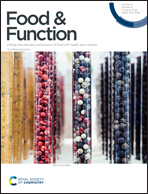Effects of mono- and di-glycerides/phospholipids (MDG/PL) on the bioaccessibility of lipophilic nutrients in a protein-based emulsion system
Abstract
Lipophilic nutrients are known to have relatively poor absorption, thus limiting their bioaccessibility. Consequently, researchers in food and pharmaceutical areas are exploring different techniques to promote the efficient delivery of lipophilic nutrients. The effects of two polar lipids, namely mono-, di-glycerides (MDG) and lecithin (PL), on the bioaccessibility of lipophilic nutrients were investigated in this study with a protein-based emulsion model system. During the emulsion preparation and formation, the incorporation of MDG/PL was found to benefit the dissolution and stabilization of lipophilic nutrients, such as lutein, and could also modify the construction of the emulsion surface. An in vitro digestion study showed that the use of MDG/PL could significantly increase the bioaccessibility of lipophilic nutrients [lutein, vitamin E, and docosahexaenoic acid (DHA)] by 13.52%, 186.90%, and 36.17% in a protein-based emulsion system. The use of MDG and PL decreased the interfacial tension in all the samples: protein only 20.65 mN m−1, protein-PL 6.47 mN m−1, and protein-MDG/PL 4.23 mN m−1, as well as 12.11 mN m−1, 1.26 mN m−1 and 1.16 mN m−1 with the presence of bile salts. Caco-2 cell culture results showed that, with the application of MDG/PL, the absorption rate of micelles was higher than that in the other groups and this resulted in a 70% absorption increase for lutein. Therefore, MDG/PL can improve the lipophilic nutrient absorption via promoting the affinity of formed micelles to the enterocytes of the small intestine. This study exhibited the effectiveness of MDG/PL on improving the bioaccessibility of lipophilic nutrients in a protein-based emulsion system mimicking the digestion and absorption fate of breast milk in an infant's gastric intestinal tract, thus suggesting that MDG/PL can be used as a technical pathway to improve the absorption of lipophilic nutrients.



 Please wait while we load your content...
Please wait while we load your content...